Impact of All-Sky Assimilation of Multichannel Observations from Fengyun-3F MWHS-II on Typhoon Forecasting
Abstract
1. Introduction
2. Materials and Methods
2.1. MWHS-II Radiance Data
2.2. All-Sky Data Assimilation Method
2.3. Symmetric Observation Error Model
3. Experimental Designs
3.1. Overview of Typhoon Case
3.2. Experimental Settings
3.3. Quality Control
4. Results from FY-3F MWHS-2 Experiments
4.1. Forecast Verification
4.1.1. Typhoon Track and Intensity Forecasts
4.1.2. Thermodynamic and Dynamic Structure
4.1.3. Precipitation Forecast
4.2. Channel Sensitivity
4.2.1. Comparison of Analysis Increments
4.2.2. Forecasts Comparison
5. Discussion
6. Conclusions
- Model forecasts based on the all-sky assimilation analysis of FY-3F MWHS-II radiance provided a more realistic simulation of Typhoon Yagi (2024) in closer agreement with observations. The all-sky assimilation experiment demonstrated a more robust performance compared to the clear-sky assimilation. The average errors in track, minimum sea level pressure, and max wind speed were substantially lower (31.8 km, 0.18 hPa, and 1.33 m/s), and the ETSs for the typhoon precipitation were 10–20% higher at thresholds above 10 mm. These results indicate that assimilating satellite radiance from cloud-covered regions improves forecast stability and accuracy.
- All-sky assimilation experiments using observations from different channels show varying impacts on forecasting the typhoon’s dynamic and thermal structures. Observations from the temperature-sensitive 118 GHz channel primarily improve the dynamical structure by adjusting the geopotential height field and suppressing the typhoon’s northward displacement. In contrast, the 183 GHz channel regulates moisture in the initial field, enhancing latent heat release and thermodynamic energy, which supports stronger intensity forecasts and increased rainfall.
- Joint all-sky assimilation of 118 GHz and 183 GHz channel observations leverages their complementary strengths, providing stronger constraints on atmospheric dynamics and moisture and improving initial analysis and forecast accuracy. Compared to the assimilation of individual channels, the joint all-sky assimilation reduced the minimum sea level pressure error by up to 0.67 hPa and the max wind speed error by up to 1.28 m/s. For precipitation thresholds above 10 mm, ETSs increased by 13.12% relative to the 183 GHz experiment and 4.10% relative to the 118 GHz experiment.
Author Contributions
Funding
Data Availability Statement
Acknowledgments
Conflicts of Interest
References
- Bennartz, R.; Bauer, P. Sensitivity of microwave radiances at 85–183 GHz to precipitating ice particles. Radio Sci. 2003, 38, 8075. [Google Scholar] [CrossRef]
- Wylie, D.P.; Menzel, W.P. Eight years of high cloud statistics using HIRS. J. Clim. 1999, 12, 170–184. [Google Scholar] [CrossRef]
- Ohring, G.; Bauer, P. The use of cloud and precipitation observations in data assimilation (CPDA). Q. J. R. Meteorol. Soc. 2011, 137, 1933. [Google Scholar] [CrossRef]
- Liu, Z.; Schwartz, C.S.; Snyder, C.; Ha, S. Impact of assimilating AMSU-A radiances on forecasts of 2008 Atlantic tropical cyclones initialized with a limited-area ensemble Kalman filter. Mon. Weather Rev. 2012, 140, 4017–4034. [Google Scholar] [CrossRef]
- Bao, Y.; Xu, J.; Powell, A.M., Jr.; Shao, M.; Min, J.; Pan, Y. Impacts of AMSU-A, MHS and IASI data assimilation on temperature and humidity forecasts with GSI–WRF over the western United States. Atmos. Meas. Tech. 2015, 8, 4231–4242. [Google Scholar] [CrossRef]
- Newman, K.M.; Schwartz, C.S.; Liu, Z.; Shao, H.; Huang, X. Evaluating forecast impact of assimilating Microwave Humidity Sounder (MHS) radiances with a regional ensemble Kalman filter data assimilation system. Weather Forecast. 2015, 30, 964–983. [Google Scholar] [CrossRef]
- Shu, A.; Xu, D.; Zhang, S.; Shen, F.; Zhang, X.; Song, L. Impacts of multi-source microwave satellite radiance data assimilation on the forecast of Typhoon Ampil. Atmosphere 2022, 13, 1427. [Google Scholar] [CrossRef]
- Fang, D.; Chen, G.; Xu, X.; Zhao, Y.; Wang, Z. Evaluating clear-sky assimilation of FengYun-3E microwave radiance data in predicting multiple tropical cyclones over the Western North Pacific. Atmos. Res. 2025, 320, 108025. [Google Scholar] [CrossRef]
- Bauer, P.; Geer, A.J.; Lopez, P.; Salmond, D. Direct 4D-Var assimilation of all-sky radiances. Part I: Implementation. Q. J. R. Meteorol. Soc. 2010, 136, 1868–1885. [Google Scholar] [CrossRef]
- Geer, A.J.; Bauer, P. Observation errors in all-sky data assimilation. Q. J. R. Meteorol. Soc. 2011, 137, 2024–2037. [Google Scholar] [CrossRef]
- Zhang, M.; Zupanski, M.; Kim, M.; Knaff, J.A. Assimilating AMSU-A radiances in the TC core area with NOAA operational HWRF (2011) and a hybrid data assimilation system: Danielle (2010). Mon. Weather Rev. 2013, 141, 3889–3907. [Google Scholar] [CrossRef]
- Yang, C.; Liu, Z.; Bresch, J.; Rizvi, S.R.H.; Huang, X.-Y.; Min, J. AMSR2 all-sky radiance assimilation and its impact on the analysis and forecast of Hurricane Sandy with a limited-area data assimilation system. Tellus A Dyn. Meteorol. Oceanogr. 2016, 68, 30917. [Google Scholar] [CrossRef]
- Xian, Z.; Chen, K.; Zhu, J. All-sky assimilation of the MWHS-2 observations and evaluation of the impacts on the analyses and forecasts of binary typhoons. J. Geophys. Res. Atmos. 2019, 124, 6359–6378. [Google Scholar] [CrossRef]
- Wang, J.; Zhang, L.; Guan, J.; Zhang, M. Comparison of assimilating all-sky and clear-sky satellite radiance for Typhoon Chan-Hom and Nangka forecasts. Atmosphere 2020, 11, 599. [Google Scholar] [CrossRef]
- Fabry, F.; Sun, J. For how long should what data be assimilated for the mesoscale forecasting of convection and why? Part I: On the propagation of initial condition errors and their implications for data assimilation. Mon. Weather Rev. 2010, 138, 242–255. [Google Scholar] [CrossRef]
- Geer, A.J.; Bormann, N.; English, S. All-Sky Assimilation of Microwave Humidity Sounders; ECMWF Technical Memoranda; European Centre for Medium-Range Weather Forecasts: Reading, UK, 2014; p. 741. Available online: https://www.ecmwf.int/en/elibrary/74553-all-sky-assimilation-microwave-humidity-sounders (accessed on 25 April 2025).
- Zhu, Y.; Liu, E.; Mahajan, R.; Thomas, C.; Groff, D.; Van Delst, P.; Collard, A.; Kleist, D.; Treadon, R.; Derber, J.C. All-sky microwave radiance assimilation in NCEP’s GSI analysis system. Mon. Weather Rev. 2016, 144, 4709–4735. [Google Scholar] [CrossRef]
- Xu, D.; Huang, L.; Min, J.; Jiang, L.; Shen, F.; Lei, Y. Impacts of the all-sky assimilation of FY-3D and FY-3E MWHS-2 radiances on analyses and forecasts of Typhoon Muifa (2022). Atmos. Res. 2024, 310, 107646. [Google Scholar] [CrossRef]
- Weng, F. Advances in radiative transfer modeling in support of satellite data assimilation. J. Atmos. Sci. 2007, 64, 3799–3807. [Google Scholar] [CrossRef]
- Weng, F.; Liu, Q. Satellite data assimilation in numerical weather prediction models. Part I: Forward radiative transfer and Jacobian modeling in cloudy atmospheres. J. Atmos. Sci. 2003, 60, 2633–2646. [Google Scholar] [CrossRef]
- Bauer, P.; Moreau, E.; Chevallier, F.; O’Keeffe, U. Multiple-scattering microwave radiative transfer for data assimilation applications. Q. J. R. Meteorol. Soc. 2006, 132, 1259–1281. [Google Scholar] [CrossRef]
- Bi, M.; Zou, X. Comparison of cloud/rain band structures of Typhoon Muifa (2022) revealed in FY-3E MWHS-2 observations with all-sky simulations. J. Geophys. Res. Atmos. 2023, 128, e2023JD039410. [Google Scholar] [CrossRef]
- Eyre, J.R. Assimilation of satellite data in numerical weather prediction. Part II: Recent years. Q. J. R. Meteorol. Soc. 2021, 148, 521–556. [Google Scholar] [CrossRef]
- Xiao, H.; Li, J.; Liu, G.; Wang, L.; Bai, Y. Assimilation of AMSU-A surface-sensitive channels in CMA_GFS 4D-Var system over land. Weather Forecast. 2023, 38, 1777–1790. [Google Scholar] [CrossRef]
- Carminati, F.; Migliorini, S. All-sky Data Assimilation of MWTS-2 and MWHS-2 in the Met Office Global NWP System. Adv. Atmos. Sci. 2021, 38, 1682–1694. [Google Scholar] [CrossRef]
- Sun, W.; Xu, Y. Assimilation of FY-3D MWHS-2 radiances with WRF Hybrid-3DVAR system for the forecast of heavy rainfall evolution associated with Typhoon Ampil. Mon. Weather Rev. 2021, 149, 1419–1437. [Google Scholar] [CrossRef]
- Chen, K.; Chen, Z.; Xian, Z.; Li, G. Impacts of the all-sky assimilation of FY-3C and FY-3D MWHS-2 radiances on analyses and forecasts of Typhoon Hagupit. Remote Sens. 2023, 15, 2279. [Google Scholar] [CrossRef]
- Xiao, H.; Han, W.; Zhang, P.; Bai, Y. Assimilation of data from the MWHS-II onboard the first early morning satellite FY-3E into the CMA global 4D-Var system. Meteorol. Appl. 2023, 30, e2133. [Google Scholar] [CrossRef]
- Xie, X.; Guo, Y.; He, J.; Yu, X.; Hu, A.; Gu, S. Calibration of Microwave Humidity Sounder-II onboard FengYun-3F in pre/postlaunch phases. IEEE Trans. Geosci. Remote Sens. 2024, 62, 5302009. [Google Scholar] [CrossRef]
- Lawrence, H.; Bormann, N.; Lu, Q.; Geer, A.; English, S. An Evaluation of FY-3C MWHS-2 at ECMWF. EUMETSAT/ECMWF Fellowship Programme Research Report No. 37; ECMWF: Reading, UK, 2015; Available online: https://www.ecmwf.int/en/elibrary/75346-evaluation-fy-3c-mwhs-2-ecmwf (accessed on 25 April 2025).
- Hocking, J.; Rayer, P.; Rundle, D.; Saunders, R. RTTOV v12 Users Guide, NWPSAF-MO-UD-037, NWP SAF; EUMETSAT: Darmstadt, Germany, 2019. [Google Scholar]
- Parrish, D.F.; Derber, J.C. The National Meteorological Center’s spectral statistical-interpolation analysis system. Mon. Weather Rev. 1992, 120, 1747–1763. [Google Scholar] [CrossRef]
- Geer, A.J.; Bauer, P.; O’Dell, C.W. A revised cloud overlap scheme for fast microwave radiative transfer in rain and cloud. J. Appl. Meteorol. Climatol. 2009, 48, 2257–2270. [Google Scholar] [CrossRef]
- Zhan, R.; Feng, J. Causes and predictability of the “explosive” intensification of Super Typhoon Yagi after entering the South China Sea in 2024. Sci. China Earth Sci. 2025, 68, 1298–1302. [Google Scholar] [CrossRef]
- Knapp, K.R.; Kruk, M.C.; Levinson, D.H.; Diamond, H.J.; Neumann, C.J. The International Best Track Archive for Climate Stewardship (IBTrACS): Unifying tropical cyclone best track data. Bull. Am. Meteorol. Soc. 2010, 91, 363–376. [Google Scholar] [CrossRef]
- Gahtan, J.; Knapp, K.R.; Schreck, C.J.; Diamond, H.J.; Kossin, J.P.; Kruk, M.C. International Best Track Archive for Climate Stewardship (IBTrACS) Project, Version 4r01; NOAA National Centers for Environmental Information: Asheville, NC, USA, 2024; [ALL]. [CrossRef]
- Lin, Y.; Farley, R.D.; Orville, H.D. Bulk parameterization of the snow field in a cloud model. J. Appl. Meteorol. Climatol. 1983, 22, 1065–1092. [Google Scholar] [CrossRef]
- Kain, J.S. The Kain–Fritsch convective parameterization: An update. J. Appl. Meteorol. 2004, 43, 170–181. [Google Scholar] [CrossRef]
- Dudhia, J. Numerical study of convection observed during the winter monsoon experiment using a mesoscale two-dimensional model. J. Atmos. Sci. 1989, 46, 3077–3107. [Google Scholar] [CrossRef]
- Mlawer, E.J.; Taubman, S.J.; Brown, P.D.; Iacono, M.J.; Clough, S.A. Radiative transfer for inhomogeneous atmospheres: RRTM, a validated correlated-k model for the longwave. J. Geophys. Res. Atmos. 1997, 102, 16663–16682. [Google Scholar] [CrossRef]
- Hu, X.-M.; Klein, P.M.; Xue, M. Evaluation of the updated YSU planetary boundary layer scheme within WRF for wind resource and air quality assessments. J. Geophys. Res. Atmos. 2013, 118, 10490–10505. [Google Scholar] [CrossRef]
- Auligné, T.; McNally, A.P.; Dee, D.P. Adaptive bias correction for satellite data in a numerical weather prediction system. Q. J. R. Meteorol. Soc. 2007, 133, 631–642. [Google Scholar] [CrossRef]
- Roberts, N.M.; Lean, H.W. Scale-Selective Verification of Rainfall Accumulations from High-Resolution Forecasts of Convective Events. Mon. Weather. Rev. 2008, 136, 78–97. [Google Scholar] [CrossRef]
- Sun, W.; Yu, R.; Li, J.; Yuan, W. Three-dimensional circulation structure of summer heavy rainfall in central North China. Weather Forecast. 2015, 30, 238–250. [Google Scholar] [CrossRef]
- Sun, W.; Li, J.; Yu, R.; Yuan, W. Circulation structures leading to propagating and non-propagating heavy summer rainfall in central North China. Clim. Dyn. 2018, 51, 3447–3465. [Google Scholar] [CrossRef]
- Li, J.; Wang, G.; Lin, W.; He, Q.; Feng, Y.; Mao, J. Cloud-scale simulation study of Typhoon Hagupit (2008) Part II: Impact of cloud microphysical latent heat processes on typhoon intensity. Atmos. Res. 2013, 120–121, 202–215. [Google Scholar] [CrossRef]
- Zhao, D.; Yu, Y.; Yin, J.; Wang, W.; Chen, X. Effects of microphysical latent heating on the rapid intensification of Typhoon Hato (2017). J. Meteorol. Res. 2020, 34, 368–386. [Google Scholar] [CrossRef]
- Wu, Y.; Qin, Z.; Li, J.; Bai, X. Primary Impact Evaluation of Surface Temperature Observations for Microwave Temperature Sounding Data Assimilation over Land. Remote Sens. 2024, 16, 395. [Google Scholar] [CrossRef]
- He, W.; Liu, Z.; Chen, H. Influence of surface temperature and emissivity on AMSU-A assimilation over land. Acta Meteorol. Sin. 2011, 25, 545–557. [Google Scholar] [CrossRef]
- Chen, M.; Huang, X.; Wang, W. The WRF-Based Incremental Analysis Updates and Its Implementation in an Hourly Cycling Data Assimilation System. Weather Forecast. 2023, 38, 1063–1078. [Google Scholar] [CrossRef]

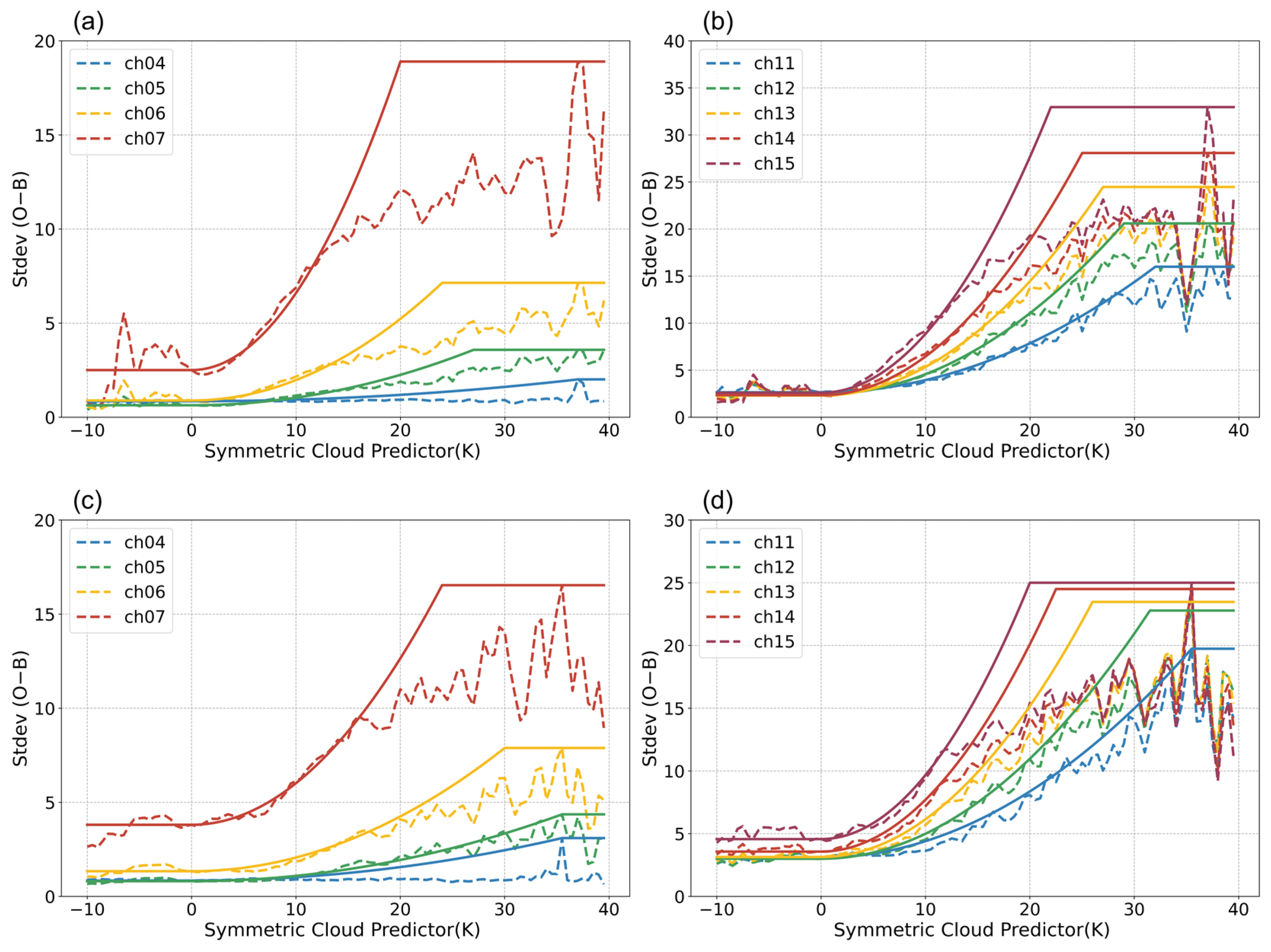
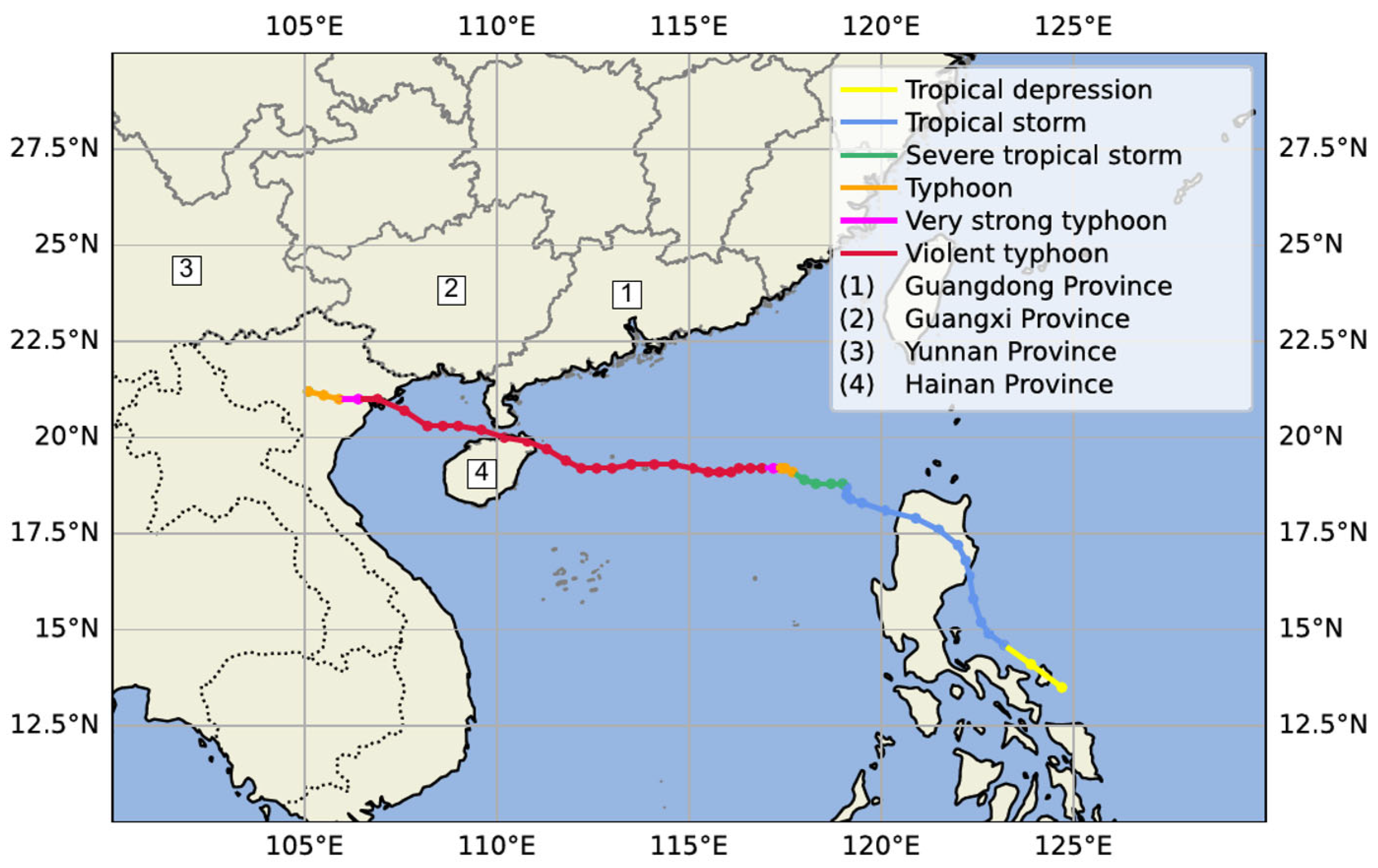

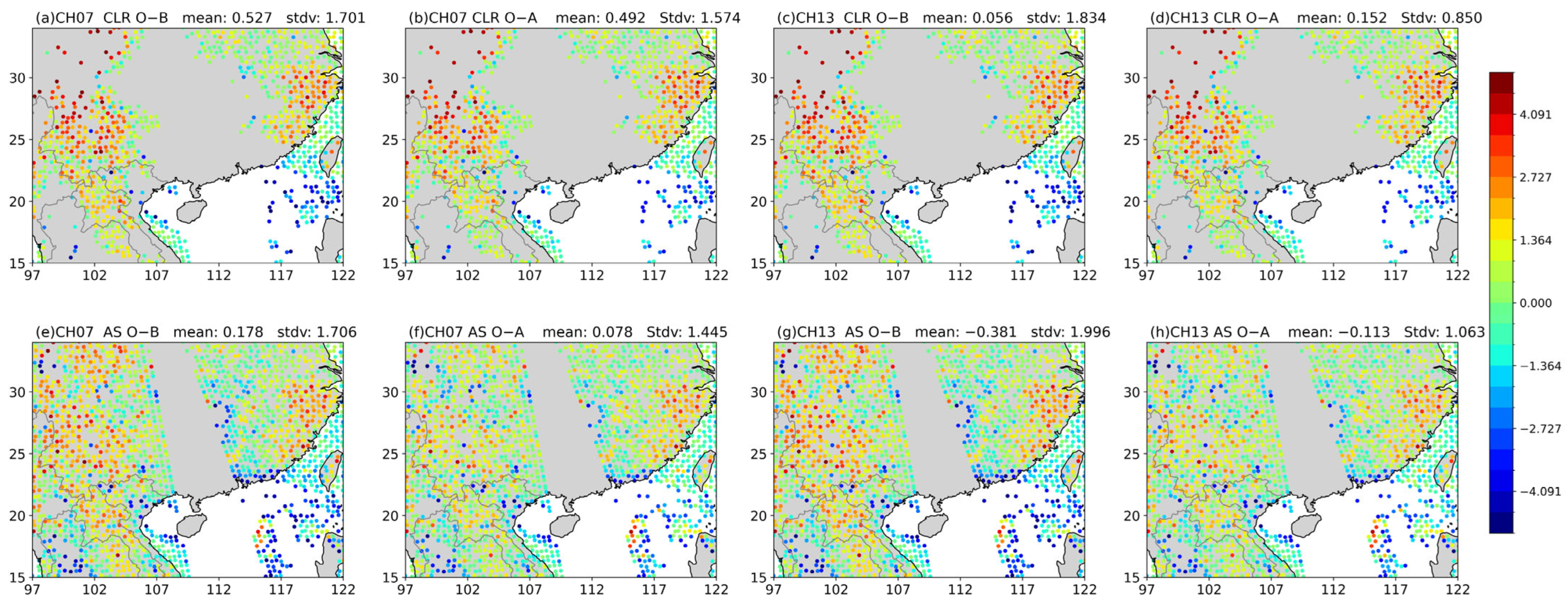
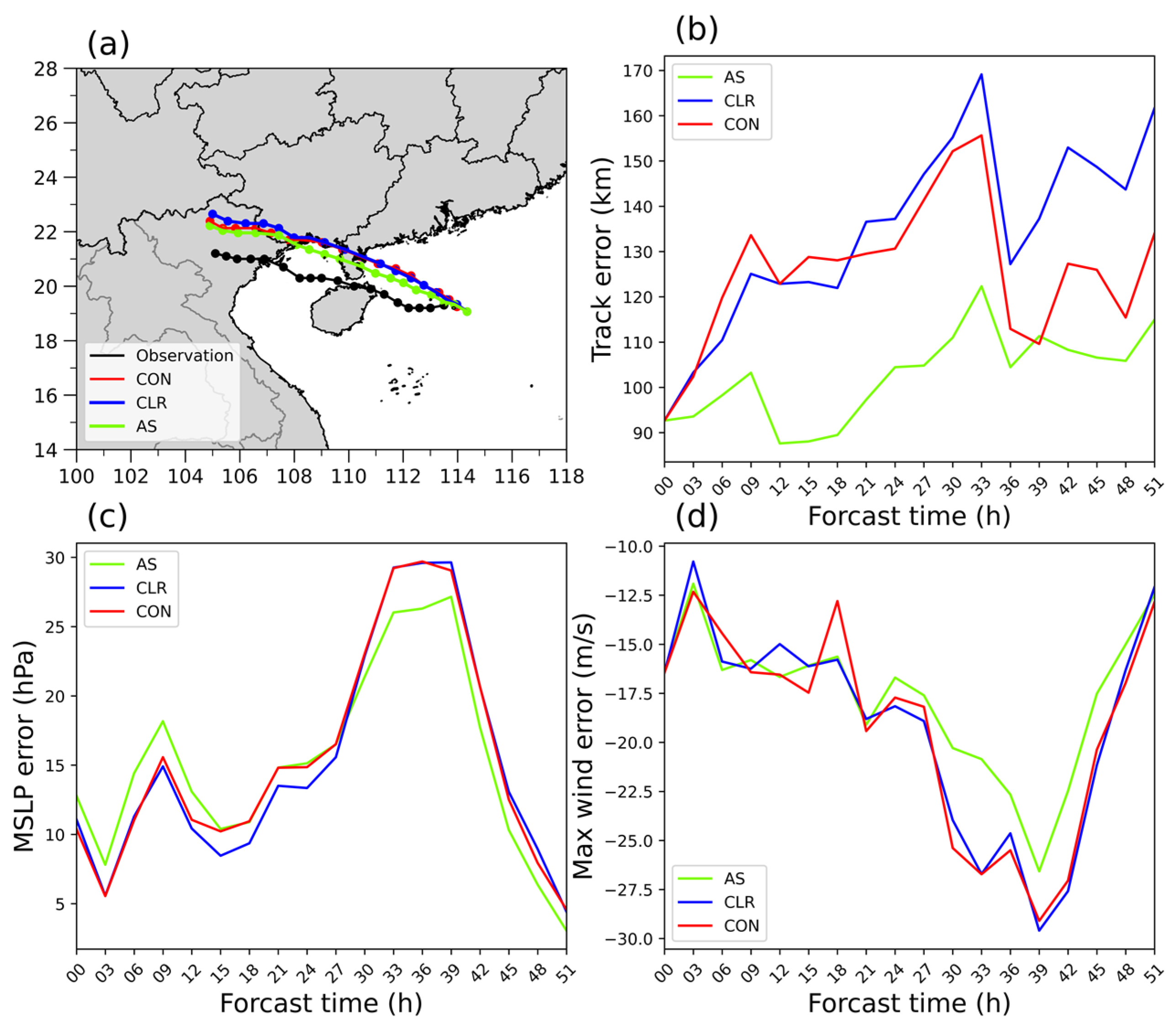
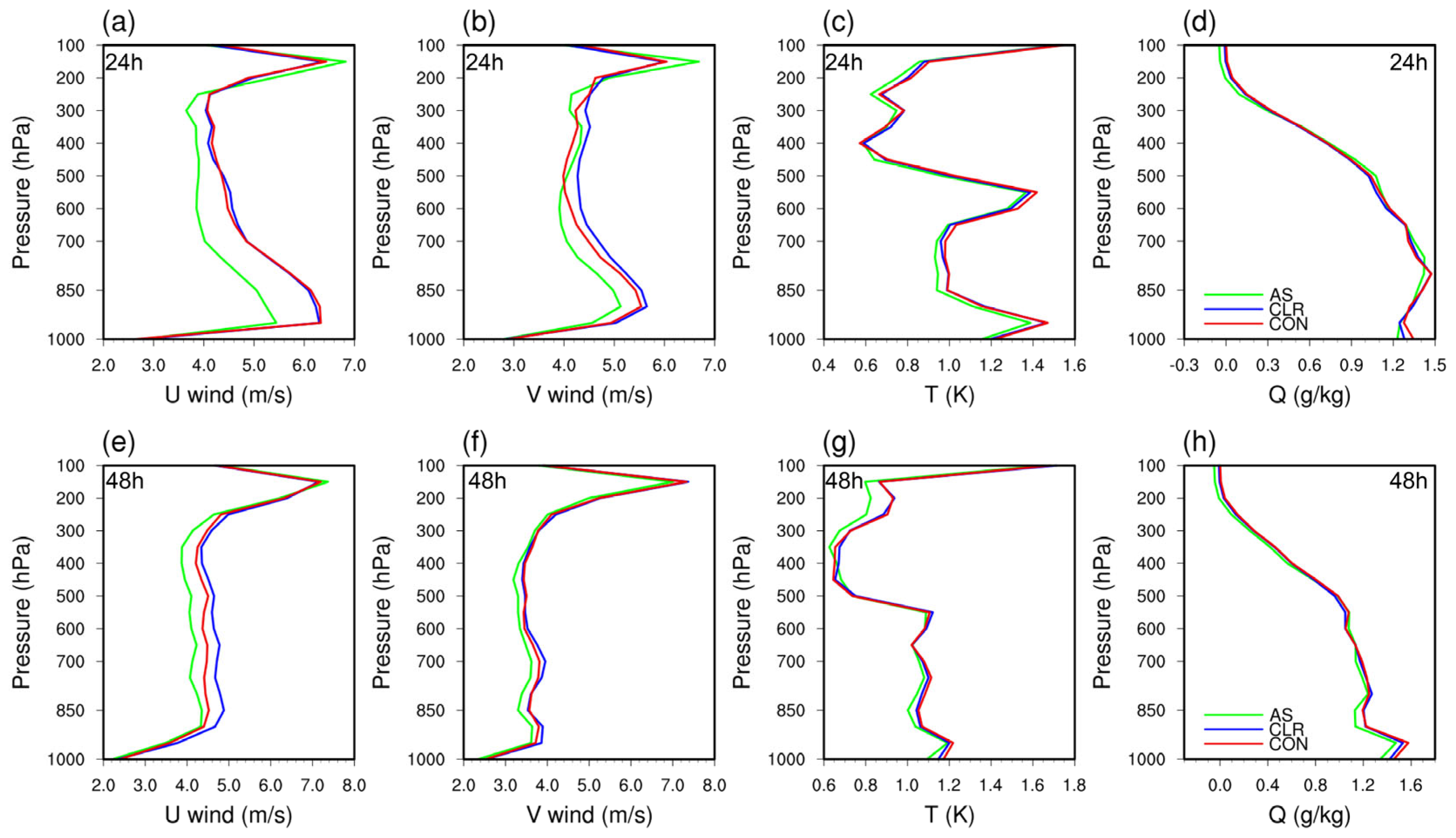
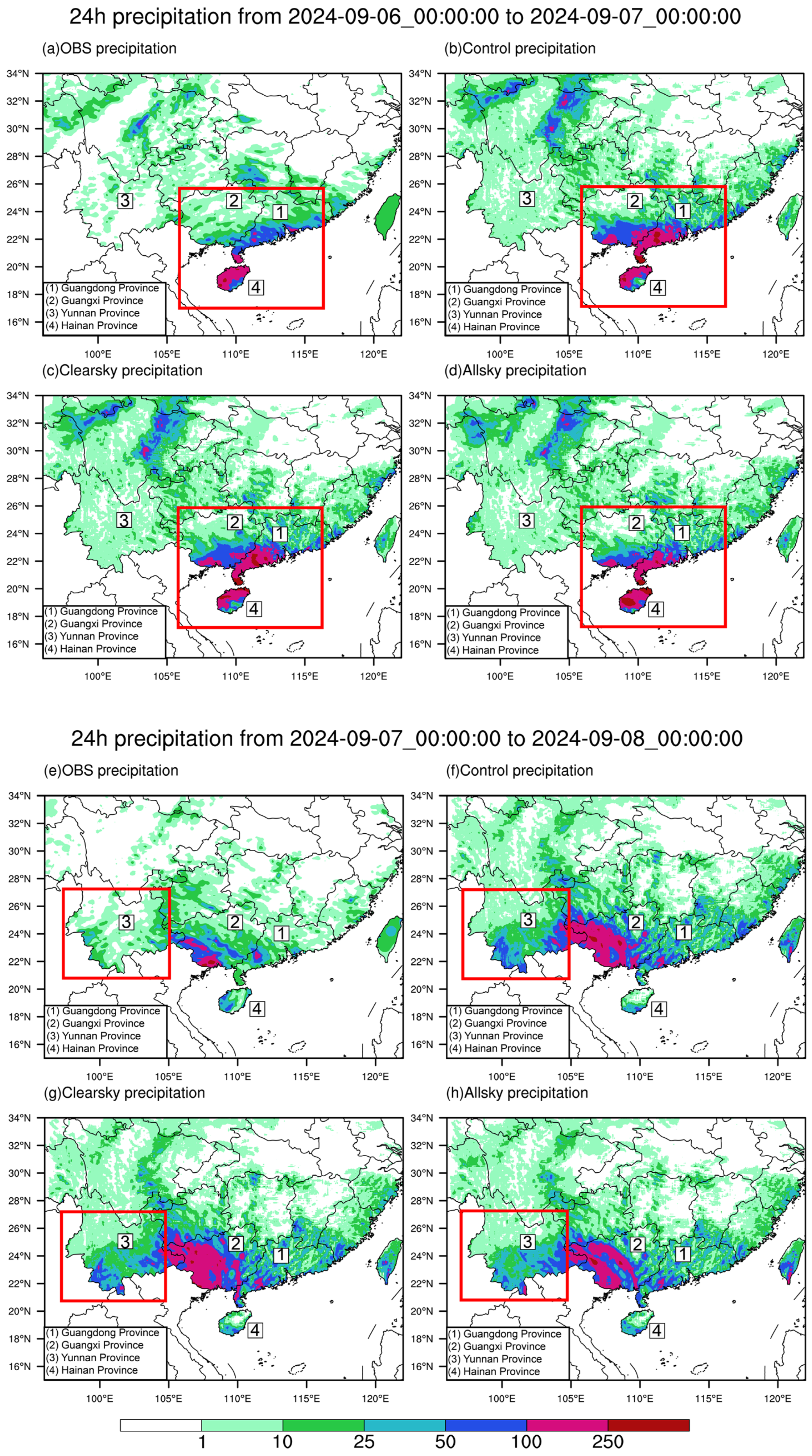

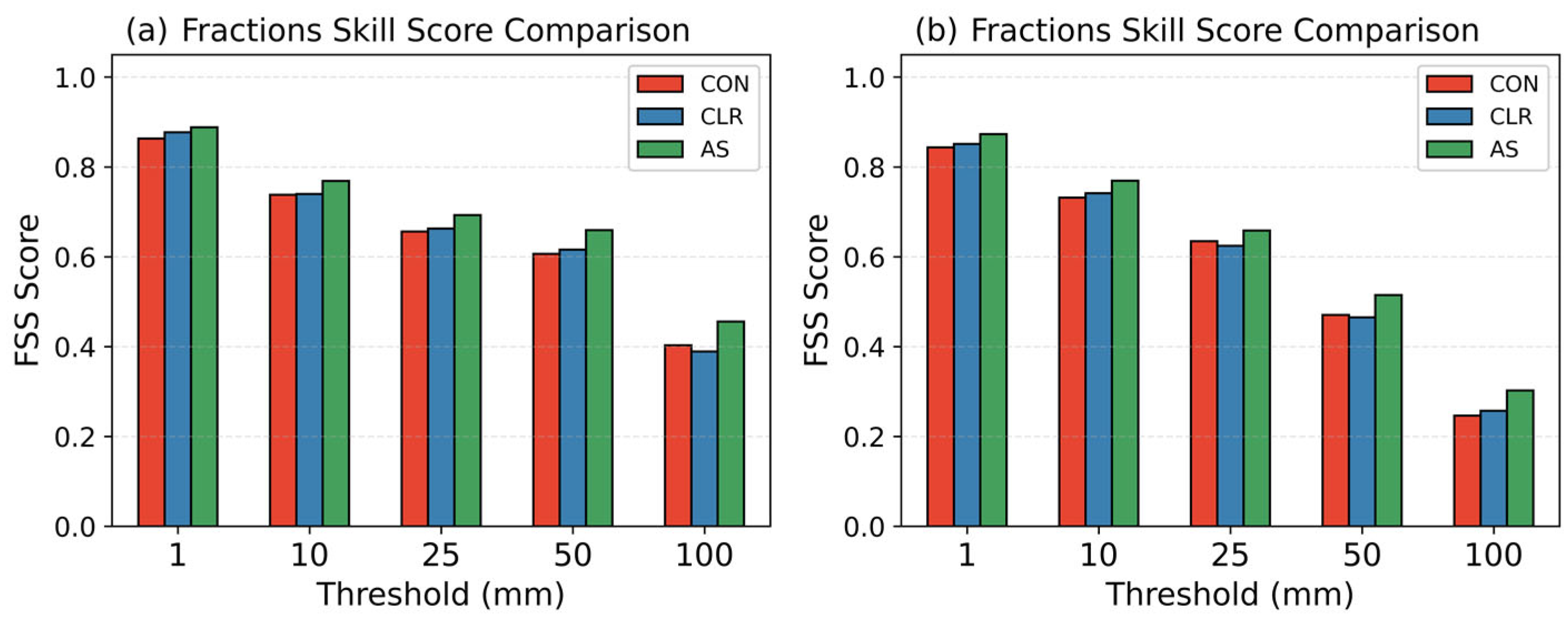
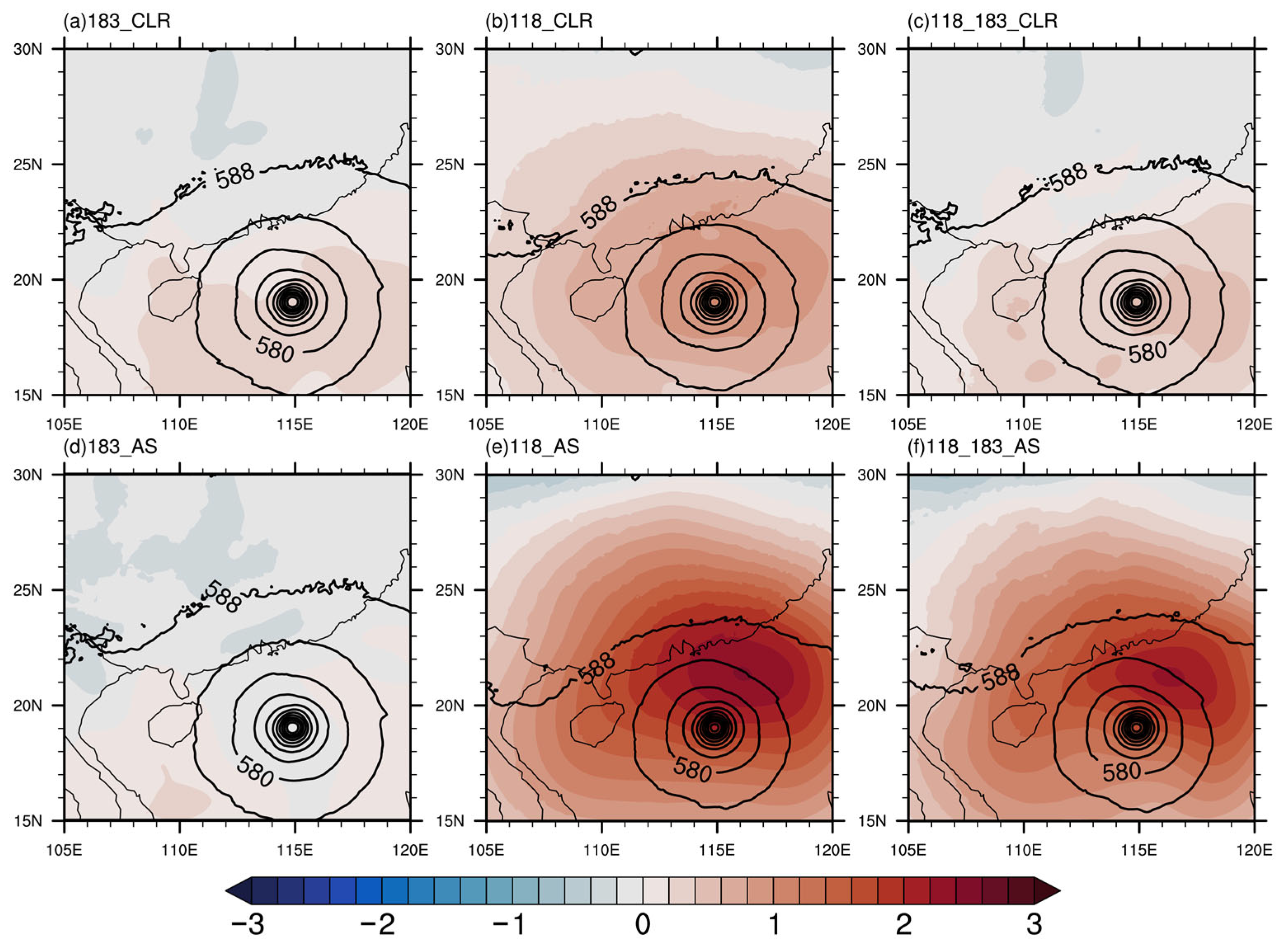
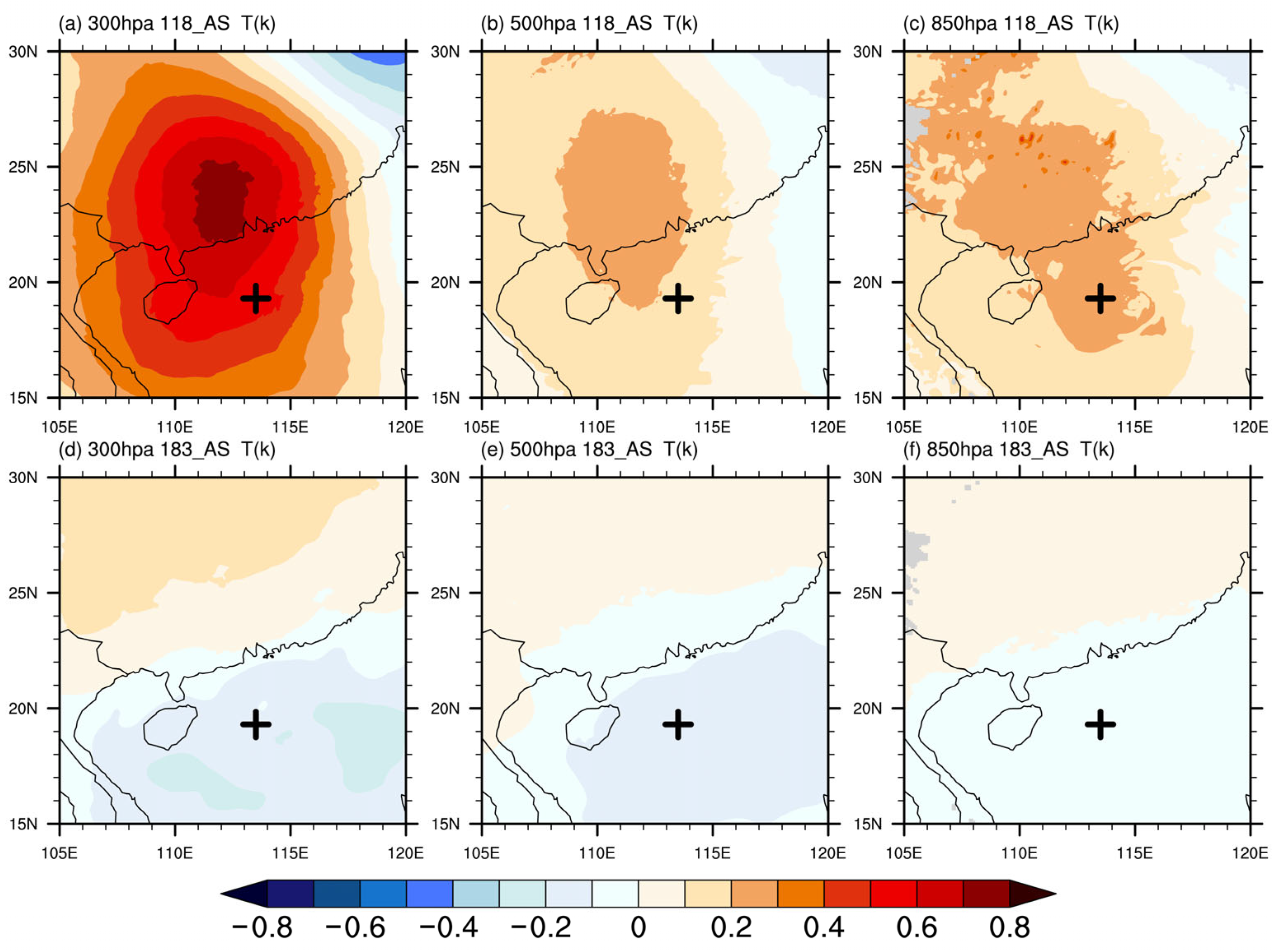
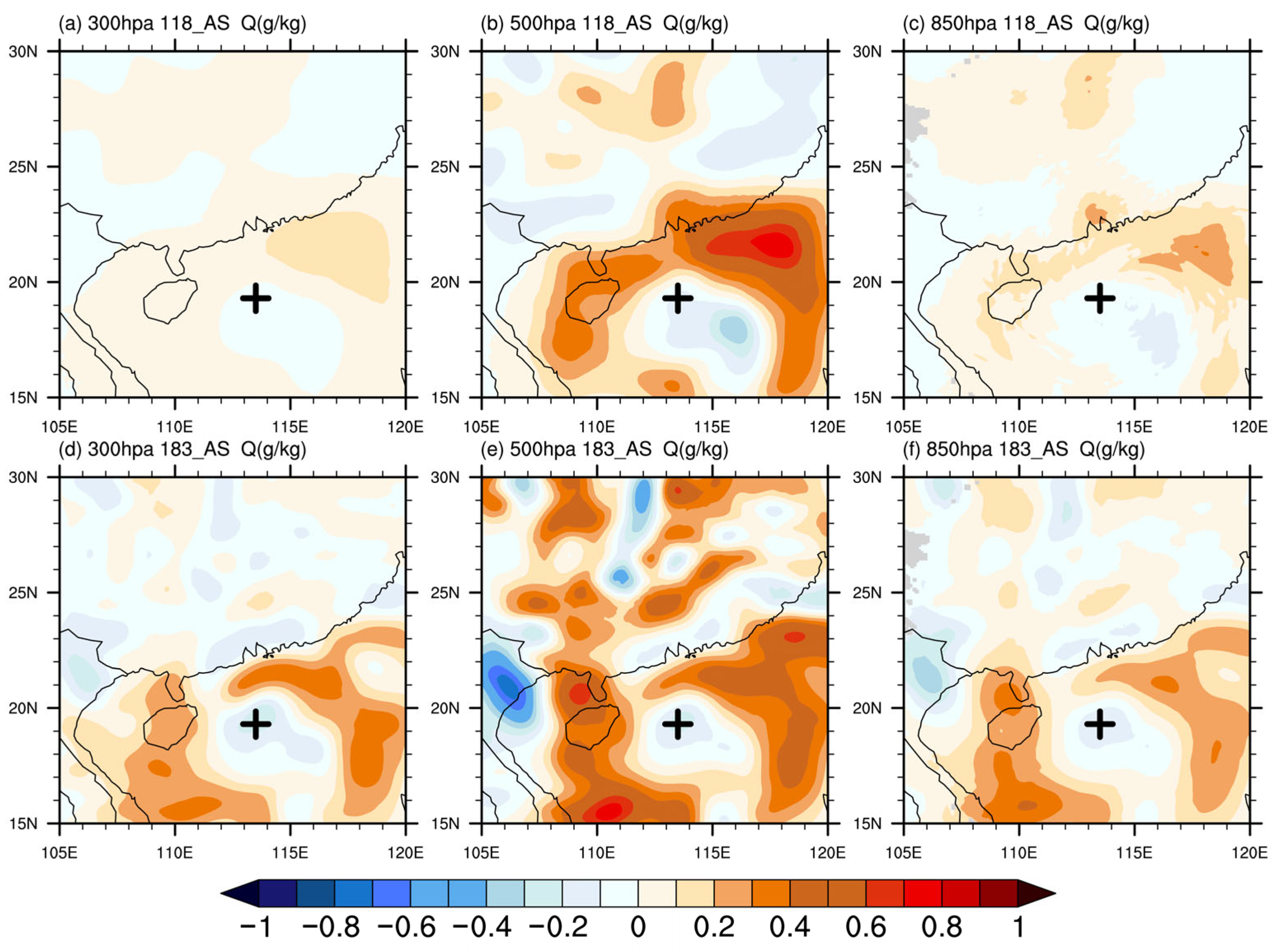
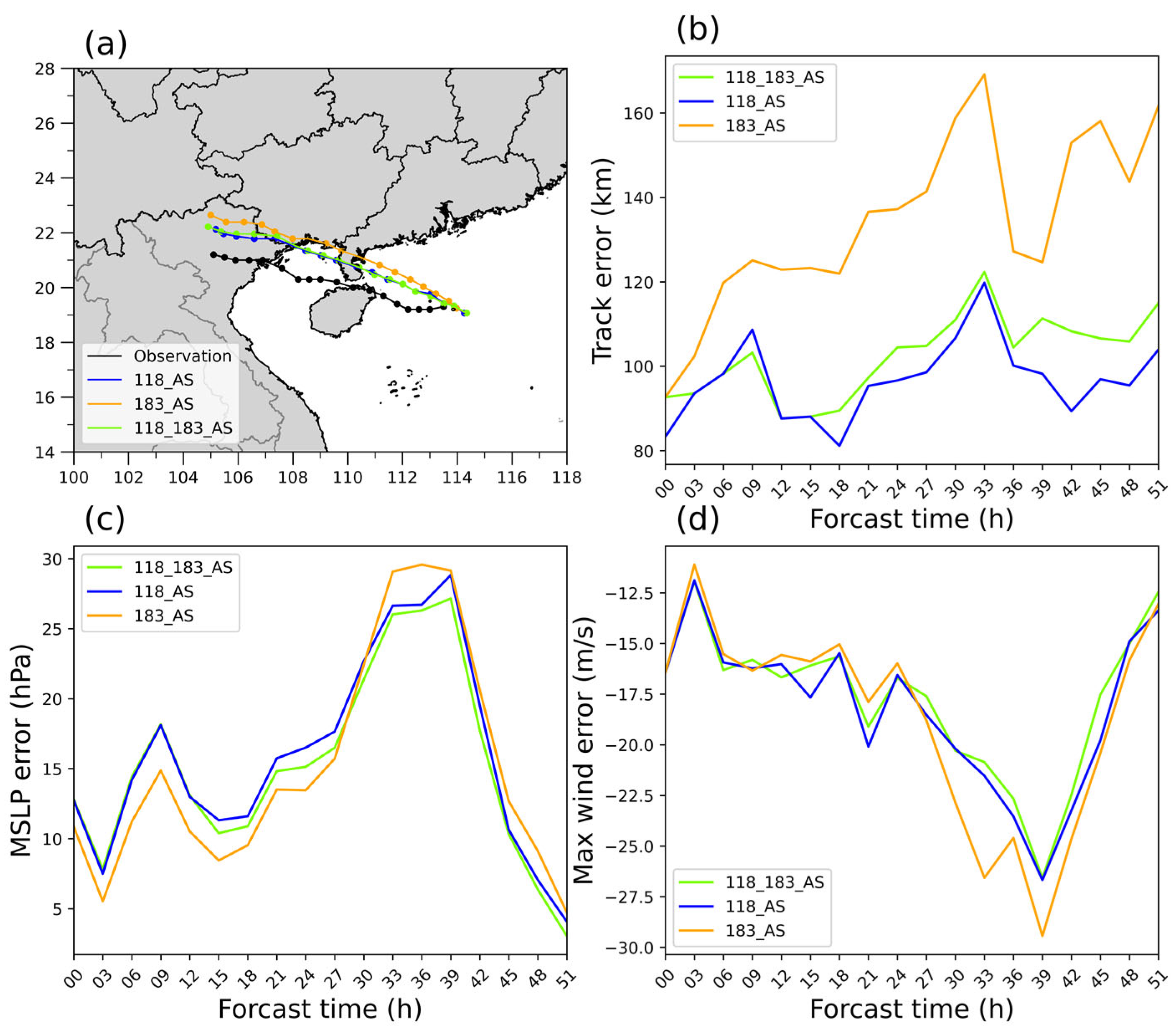


| Channel Number | Central Frequency (GHz) | Field of View (FOV) | Resolution (km) | Bandwidth (MHz) |
|---|---|---|---|---|
| 1 | 89.0 (V) | 98 | 30 | 1500 |
| 2 | 118.75 ± 0.08 (H) | 98 | 30 | 20 |
| 3 | 118.75 ± 0.2 (H) | 98 | 30 | 100 |
| 4 | 118.75 ± 0.3 (H) | 98 | 30 | 165 |
| 5 | 118.75 ± 0.8 (H) | 98 | 30 | 200 |
| 6 | 118.75 ± 1.1 (H) | 98 | 30 | 200 |
| 7 | 118.75 ± 2.5 (H) | 98 | 30 | 200 |
| 8 | 118.75 ± 3.0 (H) | 98 | 30 | 1000 |
| 9 | 118.75 ± 5.0 (H) | 98 | 30 | 2000 |
| 10 | 166.0 (V) | 98 | 15 | 1500 |
| 11 | 183.31 ± 1 (H) | 98 | 15 | 500 |
| 12 | 183.31 ± 1.8 (H) | 98 | 15 | 700 |
| 13 | 183.31 ± 3 (H) | 98 | 15 | 1000 |
| 14 | 183.31 ± 3 (H) | 98 | 15 | 2000 |
| 15 | 183.31 ± 7 (H) | 98 | 15 | 2000 |
| Experiment Name | Experiment Configuration |
|---|---|
| CON | No data assimilation |
| 118_183_CLR (CLR) | MWHS-II 118 GHz + 183 GHz clear-sky data |
| 118_CLR | MWHS-II 118 GHz clear-sky data |
| 183_CLR | MWHS-II 183 GHz clear-sky data |
| 118_183_AS (AS) | MWHS-II 118 GHz + 183 GHz all-sky data |
| 118_AS | MWHS-II 118 GHz all-sky data |
| 183_AS | MWHS-II 183 GHz all-sky data |
| Atmospheric Variable Name | Unit |
|---|---|
| Temperature | K |
| Water vapor mixing ratio | g/kg |
| Pressure | hPa |
| Zonal wind component (u) and Meridional wind component (v) | m/s |
| 2 m temperature | K |
| 2 m water vapor mixing ratio | g/kg |
| 10 m Zonal wind component (u) and Meridional wind component (v) | m/s |
| Surface pressure | hPa |
Disclaimer/Publisher’s Note: The statements, opinions and data contained in all publications are solely those of the individual author(s) and contributor(s) and not of MDPI and/or the editor(s). MDPI and/or the editor(s) disclaim responsibility for any injury to people or property resulting from any ideas, methods, instructions or products referred to in the content. |
© 2025 by the authors. Licensee MDPI, Basel, Switzerland. This article is an open access article distributed under the terms and conditions of the Creative Commons Attribution (CC BY) license (https://creativecommons.org/licenses/by/4.0/).
Share and Cite
Wang, T.; Sun, W.; Ping, F. Impact of All-Sky Assimilation of Multichannel Observations from Fengyun-3F MWHS-II on Typhoon Forecasting. Remote Sens. 2025, 17, 2056. https://doi.org/10.3390/rs17122056
Wang T, Sun W, Ping F. Impact of All-Sky Assimilation of Multichannel Observations from Fengyun-3F MWHS-II on Typhoon Forecasting. Remote Sensing. 2025; 17(12):2056. https://doi.org/10.3390/rs17122056
Chicago/Turabian StyleWang, Tianheng, Wei Sun, and Fan Ping. 2025. "Impact of All-Sky Assimilation of Multichannel Observations from Fengyun-3F MWHS-II on Typhoon Forecasting" Remote Sensing 17, no. 12: 2056. https://doi.org/10.3390/rs17122056
APA StyleWang, T., Sun, W., & Ping, F. (2025). Impact of All-Sky Assimilation of Multichannel Observations from Fengyun-3F MWHS-II on Typhoon Forecasting. Remote Sensing, 17(12), 2056. https://doi.org/10.3390/rs17122056






